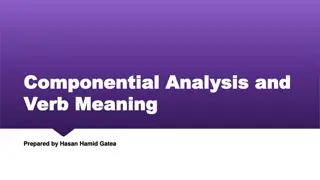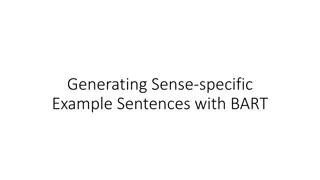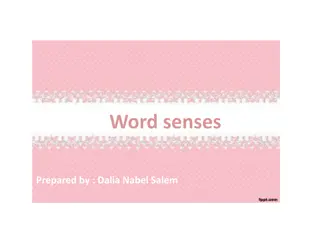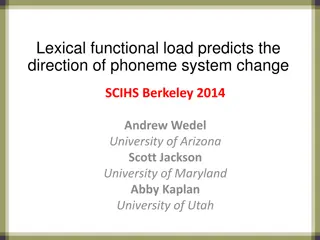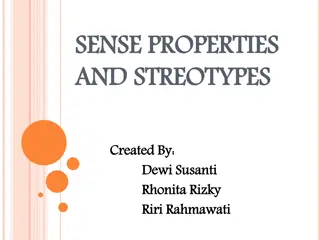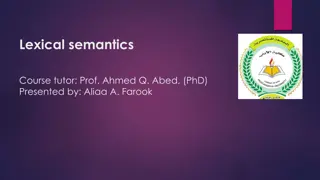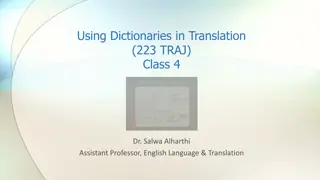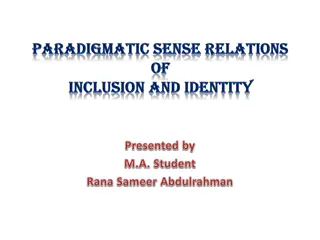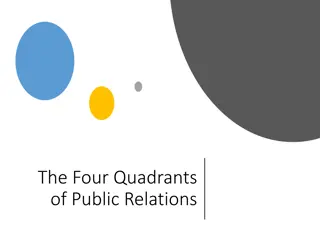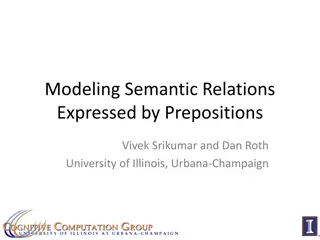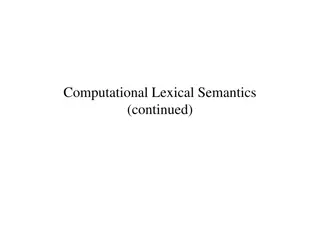Lexical Sense Relations and Word Meanings
Investigating sense relations between words involves exploring synonyms, antonyms, hyponymy, and meronymy to understand the meanings of words in different contexts. By examining semantic similarities and syntactic relationships, one can better comprehend how words relate to one another, leading to a deeper understanding of their nuances and usage.
Download Presentation

Please find below an Image/Link to download the presentation.
The content on the website is provided AS IS for your information and personal use only. It may not be sold, licensed, or shared on other websites without obtaining consent from the author.If you encounter any issues during the download, it is possible that the publisher has removed the file from their server.
You are allowed to download the files provided on this website for personal or commercial use, subject to the condition that they are used lawfully. All files are the property of their respective owners.
The content on the website is provided AS IS for your information and personal use only. It may not be sold, licensed, or shared on other websites without obtaining consent from the author.
E N D
Presentation Transcript
* Lexical sense relations
* Table of Content 1- Lexical sense relations 1.1- Meaning relations between words 1.2- Identifying sense relations 1.2.1- Synonyms 1.2.2-Antonyms 1.2.2.1- Complementary pairs (simple antonyms) 1.2.2.2- Gradable (scalar) antonyms 1.2.2.3- Converse pairs 1.2.2.4- Reverse pairs 1.2.3- Hyponymy and taxonomy 1.2.4- Meronymy 1.3-Defining words in terms of sense relations
* 1.1- Meaning relations between words *A traditional way of investigating the meaning of a word is to study the relationships between its meaning and the meanings of other words: which words have the same meaning, opposite meanings, etc. Strictly speaking these relations hold between specific senses, rather than between words; that is why we refer to them as sense relations. For example, one sense of mad is a synonym of angry, while another sense is a synonym of crazy. *We will try to define each of these relations in terms of relations between sentence meanings, since it is easier for speakers to make reliable judgments about sentences than about words in isolation.
*1.2- Identifying sense relations *Let s begin by thinking about what kinds of meaning relations are likely to be worth studying. If we are interested in the meaning of the word big, it seems natural to look at its meaning relations with words like large, small, enormous, etc. But comparing big with words like multilingual or extradite seems unlikely to be very enlightening. The range of useful comparisons seems to be limited by some concept of semantic similarity or comparability.
*1.2- Identifying sense relations *Syntactic relationships are also relevant. The kinds of meaning relations mentioned above (same meaning, opposite meaning, etc.) hold between words which are mutually substitutable, i.e., which can occur in the same syntactic environments, as illustrated in (1a). These relations are referred to as paradigmatic sense relations. We might also want to investigate relations which hold between words which can occur in construction with each other, as illustrated in (1b). (In this example we see that big can modify some head nouns but not others.) These relations are referred to as syntagmatic relations. *(1) a. Look at that big/large/small/enormous/?#discontinuous/ *snore mosquito! *b. Look at that big mosquito/elephant/?#surname/#color/ *discontinuous/*snore!
*1.2.1- Synonyms We often speak of synonyms as being words that mean the same thing . As a more rigorous definition, we will say that two words are synonymous (for a specific sense of each word) if substituting one word for the other does not change the meaning of a sentence. For example, we can change sentence (2a) into sentence (2b) by replacing frightened with scared. The two sentences are semantically equivalent (each entails the other). This shows that frightened is a synonym of scared. (2) a. John frightened the children. b. John scared the children.
*1.2.1- Synonyms * Perfect synonymy is extremely rare, and some linguists would say that it never occurs. Even for senses that are truly equivalent in meaning, there are often collocational differences as illustrated in (3 4). (3) a. John filled the bucket/pail. b. John kicked the bucket/ pail. (4) a. Susan lives in a big/large house. b. Susan lives with her big/large sister.1
*1.2.2-Antonyms *Antonyms are commonly defined as words with opposite meaning; but what do we mean by opposite ? We clearly do not mean as different as possible . As noted above, the meaning of big is totally different from the meanings of multilingual or extradite, but neither of these words is an antonym of big. When we say that big is the opposite of small, or that dead is the opposite of alive, we mean first that the two terms can have similar collocations. *So two words which are antonyms actually share most of their components of meaning, and differ only with respect to the value of one particular feature.
*1.2.2-Antonyms *Scalar or gradable antonyms: pairs of antonyms express opposite ends of a particular scale, like big and small. *Simple or complementary antonyms: express discrete values rather than points on a scale, and name the only possible values for the relevant attribute, like dead and alive.
*1.2.2.1- Complementary pairs (simple antonyms) * All men are created equal. Some, it appears, are created a little more equal than others. [Ambrose Bierce, In The San Francisco Wasp magazine, September 16, 1882] Complementary pairs such as open/shut, alive/dead, male/female, on/off, etc. exhaust the range of possibilities, for things that they can collocate with. There is (normally) no middle ground; a person is either alive or dead, a switch is either on or off, etc. The defining property of simple antonyms is that replacing one member of the pair with the other, as in (5), produces sentences which are contradictory, and the negation of one sentence entails the truth of the other, as in (6).
*1.2.2.1- Complementary pairs (simple antonyms) (5) a. The switch is on. b. The switch is off. c. The switch is neither on nor off. (6) a. The post office is not open today, but it is not closed either. b. Your headlights are not off, but they are not on either.
*1.2.2.1- Complementary pairs (simple antonyms) *A significant challenge in identifying simple antonyms is the fact that they are easily coerced into acting like gradable antonyms.2 For example, equal and unequal are simple antonyms; the humor in the quote by Ambrose Bierce at the beginning of this section arises from the way he uses equal as if it were gradable. In a similar vein, zombies are often described as being undead, implying that they are not dead but not really alive either. However, the gradable use of simple antonyms is typically possible only in certain figurative or semi-idiomatic expressions. The gradable uses in (7) seem natural, but those in (8) are not. The sentences in (9) illustrate further contrasts. For true gradable antonyms, like those discussed in the following section, all of these patterns would generally be fully acceptable, not odd or humorous.
*1.2.2.1- Complementary pairs (simple antonyms) (7) a. half-dead, half-closed, half-open b. more dead than alive c. deader than a door nail (8) a. ?half-alive b. #a little too dead c. #not dead enough d. #How dead is that mosquito? e. #This mosquito is deader than that one. (9) a. I feel fully/very/ slightly alive. b. This town/#mosquito seems very/slightly dead
*1.2.2.2- Gradable (scalar) antonyms *A defining property of gradable (or scalar) antonyms is that replacing one member of such a pair with the other produces sentences which are contrary, as illustrated in (10a b). As discussed in Chapter 3, contrary sentences are sentences which cannot both be true, though they may both be false (10c). (10) a. My youngest son-in-law is extremely diligent. b. My youngest son-in-law is extremely lazy. c. My youngest son-in-law is neither extremely diligent nor extremely lazy.
*1.2.2.2- Gradable (scalar) antonyms *Note, however, that not all pairs of words which satisfy this criterion would normally be called antonyms . The two sentences in (11) cannot both be true (when referring to the same thing), which shows that turnip and platypus are incompatibles; but they are not antonyms. So our definition of gradable antonyms needs to include the fact that, as mentioned above, they name opposite ends of a single scale and therefore belong to the same semantic domain. (11) a. This thing is a turnip. b. This thing is a platypus.
*1.2.2.2- Gradable (scalar) antonyms The following diagnostic properties can help us to identify scalar antonyms, and in particular to distinguish them from simple antonyms: *a. Scalar antonyms typically have corresponding intermediate terms, e.g. warm, tepid, cool which name points somewhere between hot and cold on the temperature scale. *b. Scalar antonyms name values which are relative rather than absolute. For example, a small elephant will probably be much bigger than a big mosquito, and the temperature range we would call hot for a bath or a cup of coffee would be very cold for a blast furnace. *c. As discussed in Chapter 5, scalar antonyms are often vague. *d. Comparative forms of scalar antonyms are completely natural (hotter, colder, etc.), whereas they are normally much less natural with complementary antonyms, as illustrated in (8e) above. *e. The comparative forms of scalar antonyms form a converse pair (see below). For example, A is longer than B *f. One member of a pair of scalar antonyms often has privileged status, or is felt to be more basic, as illustrated in (12). B is shorter than A.
*1.2.2.2- Gradable (scalar) antonyms (12) a. How old/ young are you? b. How tall/ short are you? c. How deep/ shallow is the water?
*1.2.2.3- Converse pairs *Converse pairs involve words that name an asymmetric relation between two entities, e.g. parent-child, above-below, employer-employee.5 The relation must be asymmetric or there would be no pair; symmetric relations like equal or resemble are (in a sense) their own converses. The two members of a converse pair express the same basic relation, with the positions of the two arguments reversed. If we replace one member of a converse pair with the other, and also reverse the order of the arguments, as in (13 14), we produce sentences which are semantically equivalent (paraphrases). (13) a. Michael is my advisor. b. I am Michael s advisee. (14) OWN(x,y) BELONG_TO(y,x) ABOVE(x,y) BELOW(y,x) PARENT_OF(x,y) CHILD_OF(y,x)
*1.2.2.4- Reverse pairs *Two words (normally verbs) are called reverses if they denote motion or change in opposite directions [I]n addition they should differ only in respect of directionality (Cruse 1986: 226). Examples include push/pull, come/go, fill/empty, heat/ cool, trengthen/weaken, etc. Cruse notes that some pairs of this type (but not all) allow an interesting use of again, as illustrated in (15). In these sentences, again does not mean that the action named by the second verb is repeated (repetitive reading), but rather that the situation is restored to its original state restitutive reading). (15) a. The nurse heated the instruments to sterilize them, and then cooled them again. b. George filled the tank with water, and then emptied it again.
*1.2.3- Hyponymy and Taxonomy *When two words stand in a generic-specific relationship, we refer to the more specific term (e.g. moose) as the hyponym and to the more generic term (e.g. mammal) as the superordinate or hyperonym. A generic-specific relationship can be defined by saying that a simple positive non-quantified statement involving the hyponym will entail the same statement involving the superordinate, as illustrated in (16). We need to specify that the statement is positive, because negation reverses the direction of the entailments (17). (16) a. Seabiscuit was a stallion entails: Seabiscuit was a horse. b. Fred stole my bicycle entails: Fred took my bicycle. (17) a. Seabiscuit was not a horse entails: Seabiscuit was not a stallion. b. John did not kill the Mayor entails: John did not assassinate the Mayor.
*1.2.3- Hyponymy and Taxonomy *Taxonomy is a special type of hyponymy, a classifying relation. Cruse (1986: 137) suggests the following diagnostic: X is a taxonym of Y if it is natural to say An X is a kind/type of Y. Examples of taxonomy are presented in (18a b), while the examples in (18c d) show that other hyponyms are not fully natural in this pattern. (The word taxonymy is also used to refer to a generic-specific hierarchy, or system of classification.) (18) a. A beagle is a kind of dog. b. Gold is a type of metal. c. ?A stallion is a kind of horse. d. Sunday is a kind of day of the week.
*1.2.3- Hyponymy and Taxonomy *Taxonomic sisters are taxonyms which share the same superordinate term, such as squirrel and mouse which are both hyponyms of rodent. Taxonomic sisters must be incompatible, in the sense defined above; for example, a single animal cannot be both a squirrel and a mouse. But that property alone does not distinguish taxonomy from other types of hyponymy. Taxonomic sisters occur naturally in sentences like the following: (19) a. Abeagle is a kind of dog, and so is a Great Dane. b. Gold is a type of metal, and copper is another type of metal. *Cruse notes that taxonomy often involves terms that name natural kinds (e.g., names of species, substances, etc.). Natural kind terms cannot easily be paraphrased by a superordinate term plus modifier, as many other words can (see 6.3 below): (20) a. Stallion means a male horse. b. Sunday means the first day of the week. c. Beagle means a dog. d. Gold means a metal. e. Dog means a animal.
*1.2.4- Meronymy *A meronymy is a pair of words expressing a part-whole relationship. The word naming the part is called the meronym. For example, hand, brain and eye are all meronyms of body; door, roof and kitchen are all meronyms of house; etc. Once again, it is important to remember that when we study patterns of meronymy, we are studying the structure of the lexicon, i.e., relations between words and not between the things named by the words. One linguistic test for identifying meronymy is the naturalness of sentences like the following: The parts of an X include the Y, the Z, (Cruse 1986: 161).
*1.2.4- Meronymy *A meronym is a name for a part, and not merely a piece, of a larger whole. Human languages have many words that name parts of things, but few words that name pieces. Cruse (1986: 158 159) lists three differences between parts and pieces. First, a part has autonomous identity: many shops sell automobile parts which have never been structurally integrated into an actual car. A piece of a car, on the other hand, must have come from a complete car. (Few shops sell pieces of automobile.) Second, the boundaries of a part are motivated by some kind of natural boundary or discontinuity potential for separation or motion relative to neighboring parts, joints (e.g. in the body), difference in material, narrowing of connection to the whole, etc. The boundaries of a piece are arbitrary. Third, a part typically has a definite function relative to the whole, whereas this is not true for pieces.
*1.3-Defining words in terms of sense relations *Traditional ways of defining words depend heavily on the use of sense relations; hyponymy has played an especially important role. The classical form of a definition, going back at least to Aristotle (384 322 BC), is a kind of phrasal synonym; that is, a phrase which is mutually substitutable with the word being defined (same syntactic distribution) and equivalent or nearly equivalent in meaning. The standard way of creating a definition is to start with the nearest superordinate term for the word being defined (traditionally called the genus proximum), and then add one or more modifiers (traditionally called the differentia specifica) which will unambiguously distinguish this word from its hyponymic sisters. So, for example, we might define ewe as an adult female sheep ; sheep is the superordinate term, while adult and female are modifiers which distinguish ewes from other kinds of sheep.
*1.3-Defining words in terms of sense relations *This structure can be further illustrated with the following well-known definition by Samuel Johnson lexicographer. It actually consists of two parallel definitions; the superordinate term in the first is writer, and in the second drudge. The remainder of each definition provides the modifiers which distinguish lexicographers from other kinds of writers or drudges. *(22) Lexicographer: A writer of dictionaries; a harmless drudge that busies himself in tracing the [origin], and detailing the signification of words. *Some additional examples are presented in (23). In each definition the superordinate term is bolded while the distinguishing modifiers are placed in square brackets. (23) a. fir (N): a kind of tree [with evergreen needles]. b. rectangle (N): a [right-angled] quadrilateral. c. clean (Adj): free [from dirt]. (1709 1784), himself a famous
*1.3-Defining words in terms of sense relations *However, as a number of authors have pointed out, many words cannot easily be defined in this way. In such cases, one common alternative is to define a word by using synonyms (24a b) or antonyms (24c d). *(24) a. grumpy: moodily cross; surly. b. sad: affected with or expressive of grief or unhappiness.12 c. free: not controlled by obligation or the will of another; not bound, fastened, or attached. d. pure: not mixed or adulterated with any other substance or material. Another common type of definition is the extensional definition. This definition spells out the denotation of the word rather than its sense as in a normal definition. This type is illustrated in (25).
* (25) Definitions from Merriam-Webster on-line dictionary: * a. New England: the NE United States comprising the states of Maine, * New Hampshire, Vermont, Massachusetts, Rhode Island, & * Connecticut * b. cat: any of a family (Felidae) of carnivorous, usually solitary and * nocturnal, mammals (as the domestic cat, lion, tiger, leopard, jaguar, * cougar, wildcat, lynx, and cheetah) * Some newer dictionaries, notably the COBUILD dictionary, make use of full * sentence definitions rather than phrasal synonyms, as illustrated in (26). * (26) confidential: Information that is confidential is meant to be kept secret or * private.15




